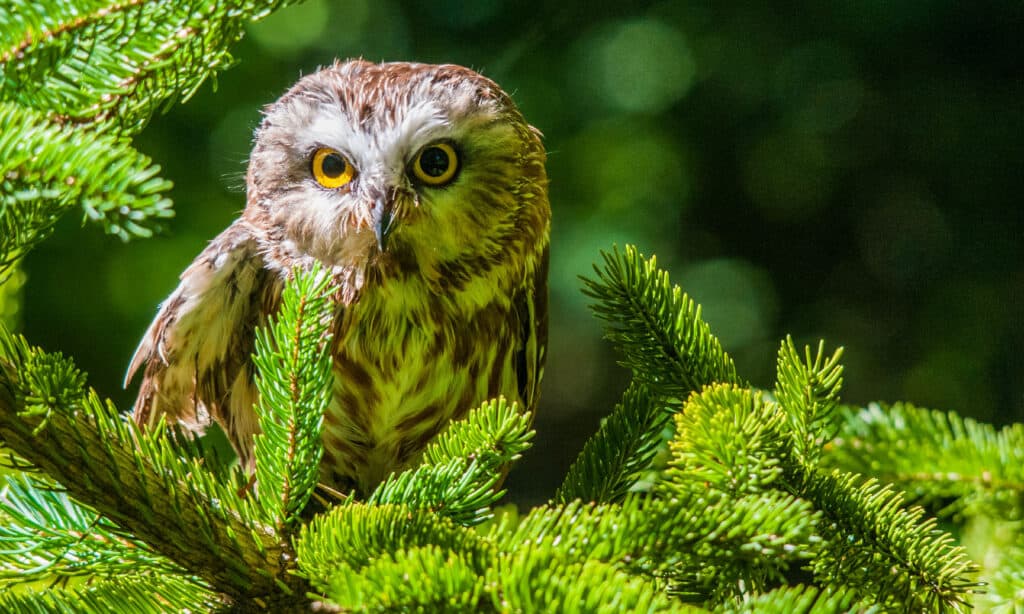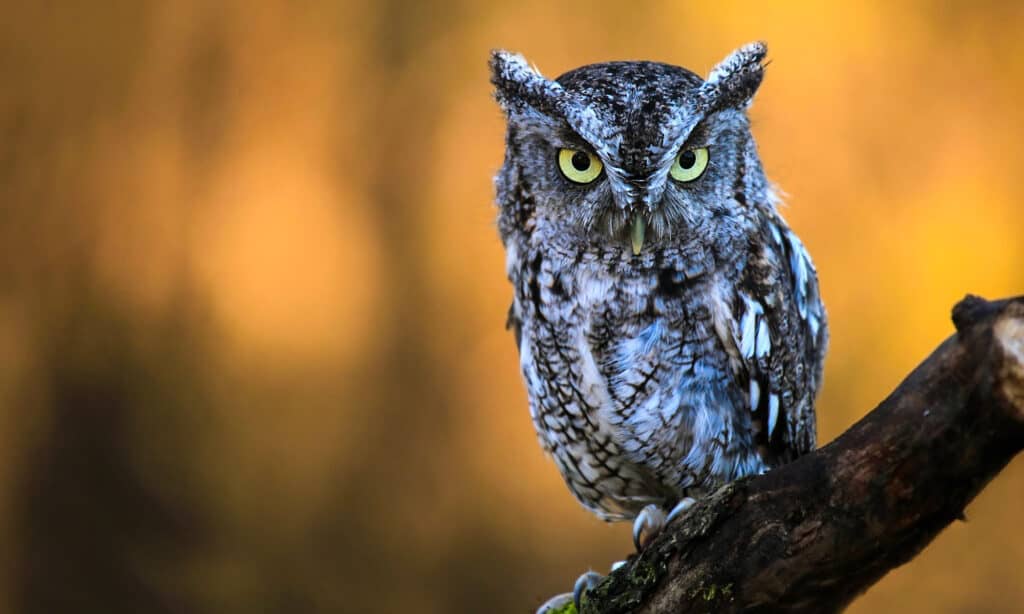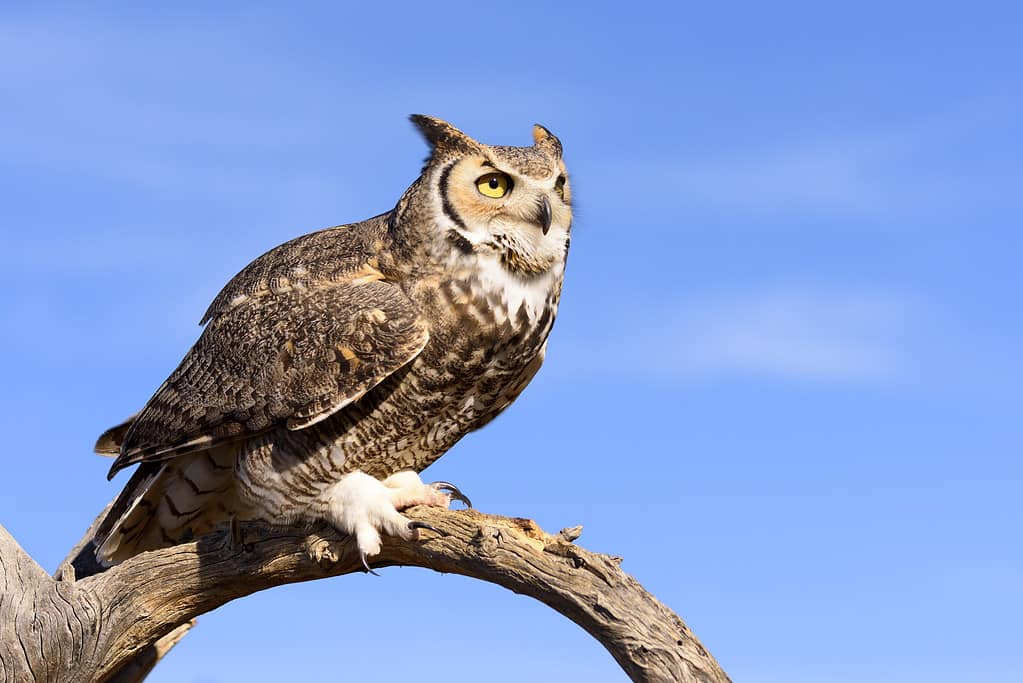Owls are fascinating birds. Although their nocturnal behavior, silent flight, and excellent camouflage make them difficult to spot, owls have still captured the attention of humans and play a symbolic role in many cultures. Many people enjoy venturing outdoors at night in the hope of spotting an owl. There are about 250 species of owls that live throughout the world. Eight of these species can be found in Missouri. Here are all eight of them, listed in order from rarest to most common.
1. Northern Saw-Whet Owl

Northern saw-whet owls are named after their call, which sounds like a saw being sharpened.
©iStock.com/bookguy
The northern saw-whet owl is the smallest type of owl in Missouri, as well as the most strictly nocturnal. Northern saw-whet owls are found throughout the state of Missouri, but they are more common in the northern half of the state. They hunt exclusively at night, in open areas. In the daytime, they stay hidden in tree cavities or dense vegetation, making them very difficult to spot. These small owls hunt small prey, including shrews, bats, small birds, and insects. Northern saw-whet owls only live in Missouri in the winter, specifically from late October to mid-March, after which they migrate north to Canada or the Great Lakes area for the summer breeding season. Even in the winter, they are quite rare in Missouri. They may become more common in “invasion” years when food shortages force them to venture outside their usual range.
2. Snowy Owl

Snowy owls usually live in the Arctic, but occasionally move farther south.
©Carol Gray/iStock via Getty Images
The snowy owl is another species that only lives in Missouri seasonally. While snowy owls usually live farther north, they appear sporadically in Missouri in the winter. Most snowy owls in Missouri are juveniles who moved south due to a lack of space after a population boom. They can be found anywhere in Missouri but are more common in the northern half of the state. Snowy owls live in open grasslands, and unlike most owls, they are active during the day. In their usual Arctic home, snowy owls primarily eat lemmings, a type of small rodent that is common in the Arctic. In Missouri, where there aren’t many lemmings, snowy owls will eat other rodents, other small mammals such as rabbits and minks, and birds such as ducks. Snowy owls are easily identifiable by their white feathers with black spots, and females are much more densely spotted than males.
3. Barn Owl

Barn owls are easy to identify by their white, heart-shaped faces.
©iStock.com/mzphoto11
The barn owl is the rarest owl in Missouri that is a year-round resident. Barn owls are widespread throughout much of the world, and in Missouri, they can be found statewide. They are highly nocturnal and tend to stay hidden during the day. Barn owls live in open woodlands and around farms. They nest and roost in cavities such as tree holes and manmade structures, including barns from which they get their name. Barn owls primarily eat small rodents, especially mice. They will also eat bats, smaller birds, reptiles, and insects. Their role in controlling rodent populations makes them a favorite of farmers, who may put up nesting boxes to attract them. Barn owls have a distinctive appearance with golden feathers, a white face, and black eyes, making them easy to identify.
4. Long-Eared Owl

Long-eared owls are named for their long ear tufts.
©Feng Yu/Shutterstock.com
The long-eared owl can be found throughout Missouri in forests, thickets, and pine plantations. Long-eared owls are highly nocturnal and spend the day roosting in dense vegetation, especially pine trees. At night, they hunt in open areas. Their prey is primarily small mammals including mice, rats, voles, shrews, and rabbits. Long-eared owls are most common in Missouri in the winter, specifically from mid-November to mid-April, though they are still uncommon then. Unlike the northern saw-whet owl and the snowy owl, long-eared owls still live in Missouri in the summer, but they are quite rare in the summer because they prefer to nest farther north. If you do spot one, look for the owl’s long ear tufts, which is where the species gets its name.
5. Short-Eared Owl

The global short-eared owl population is estimated to number 1.2 to 2.1 million mature individuals.
©iStock.com/Harry Collins
The short-eared owl can be found throughout Missouri in open grasslands. Unlike most owls, short-eared owls roost on the ground or in bushes instead of in trees. They are also active during the day, especially in the early morning and late afternoon, as well as at night. Short-eared owls eat mice, rats, lemmings, gophers, rabbits, insects, and sometimes birds. Like long-eared owls, short-eared owls are most common in Missouri in the winter, specifically between October and April, though they are still uncommon then. In the summer, short-eared owls are rare in Missouri, and they only live in certain areas including the Glaciated Plains, the Osage Plains, and the Mississippi Lowlands. They used to nest in Missouri, but they do not anymore. This may be due to grazing and hay harvesting disturbing their nests, which they build on the ground.
6. Eastern Screech Owl

Screech owls have a varied diet and hunt at night.
©mlorenz/Shutterstock.com
The eastern screech owl is a smaller owl species that comes in three colors: gray, brown, and red. In Missouri, the red variety is the rarest. Eastern screech owls are found throughout Missouri in wooded areas, especially where there are pine and cedar trees. They nest in cavities such as tree holes. As a small owl species, eastern screech-owls eat small prey, including grasshoppers, beetles, moths, mice, moles, shrews, fish, frogs, crayfish, and small birds. Eastern screech owls are common in Missouri, and they live there year-round. Like most owls, they are only active at night.
7. Great Horned Owl

Great horned owls are named for their prominent ear tufts which resemble horns.
©kojihirano/iStock via Getty Images
The great horned owl is a common species that lives throughout Missouri. These owls live in a wide variety of habitats, ranging from forests to urban areas. They also hunt a wide variety of prey, including mice, rabbits, birds such as crows, snakes, and insects. Some will hunt even larger prey such as skunks, wild turkeys, and even other owls. Great horned owls live in Missouri year-round, but their populations fluctuate with the populations of their prey. Like most owls, they are nocturnal. Great horned owls are also called “tiger owls” because they are large, fierce predators, and “hoot owls” because their call is the classic hooting sound associated with owls.
8. Barred Owl

Barred owls have a distinctive call that sounds like the phrase, “Who cooks for you? Who cooks for you all?”
©FotoRequest/Shutterstock.com
The barred owl is the most common type of owl in Missouri. These owls are found throughout the state in forests, especially deep forests near bodies of water such as lakes, rivers, streams, and swamps. Barred owls eat rabbits, small rodents, snakes, frogs, insects, crayfish, and sometimes fish. They are common in Missouri year-round. Like most owls, barred owls are mostly active at night, but they are sometimes active during the day as well. If you do spot one, you can identify them by the striped pattern on the front of their bodies and the namesake bars of different colors on the backs of their wings.
Summary of the 8 Owls in Missouri:
| Rank in Rarity | Owl |
|---|---|
| #1 | Northern Saw-Whet Owl |
| #2 | Snowy Owl |
| #3 | Barn Owl |
| #4 | Long-Eared Owl |
| #5 | Short-Eared Owl |
| #6 | Eastern Screech Owl |
| #7 | Great Horned Owl |
| #8 | Barred Owl |
The photo featured at the top of this post is © Alannyiri/ CC BY-SA 3.0 – License / Original
Thank you for reading! Have some feedback for us? Contact the AZ Animals editorial team.






